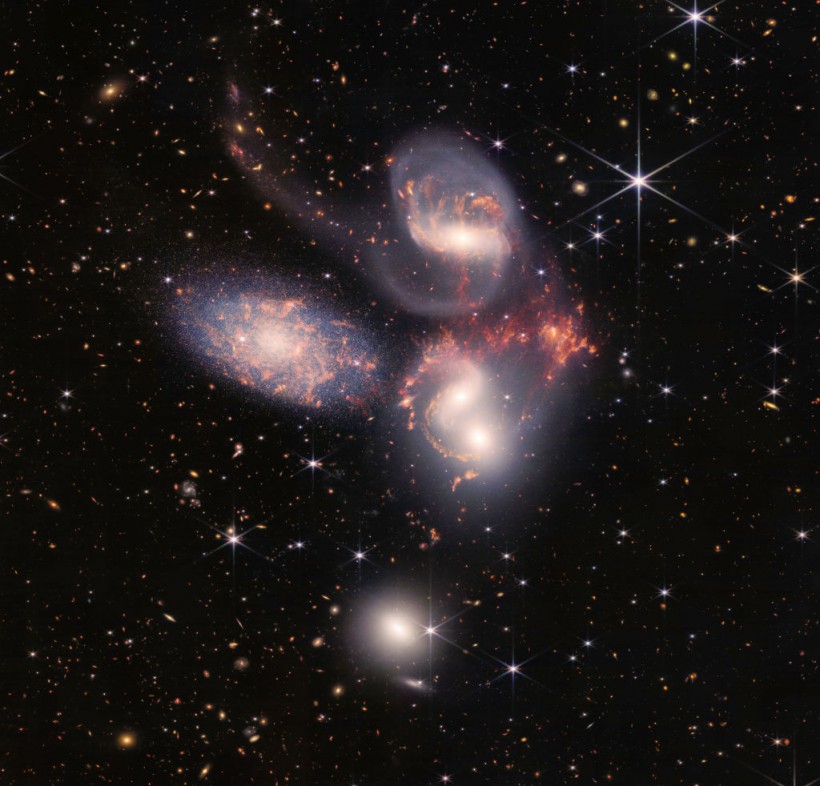NASA's $10 billion James Webb Space Telescope (JWST) has been finding galaxies that should not exist as per conventional understanding. But the six galaxies that the powerful space telescope found so far are too massive for their age, which is between 500 to 700 million years old, MailOnline reported.
Dr. Mike Boylan-Kolchin, an author of the study from the University of Texas at Austin, said that the galaxies are in the unchartered territory if their masses are indeed right. They proposed that this might be due to the universe expanding too much more quickly after the Big Bang event 13.8 million years ago.

In this handout photo provided by NASA, NASA's James Webb Space Telescope reveals Stephans Quintet, a visual grouping of five galaxies, in a new light on July 12, 2022 in space.
Six Galaxies That Are Too Big For Their Age
The JWST's goal is to detect light from the earliest celestial bodies in the universe. It unveiled its first official images in July 2021. In February, researchers from Swinburne University in Australia used data gathered by the JWST to examine six galaxies.
They estimated that the age of the first star they analyzed was 13.8 billion years old. However, the light that the JWST had detected from the star took 13 billion years to travel to Earth. This meant that the researchers were observing an image of the galaxy as it looked 700 million years after the Big Bang, which is only 5% of the current age of the universe.
Despite its age, the galaxy contained 100 billion stars, which is the same number of stars found in the current-day Milky Way galaxy that has existed for an additional 13 billion years. Similarly, the other five galaxies examined by the researchers contained more stars than would be expected for a cluster of their age.
The paper, titled "Stress testing ΛCDM with high-redshift galaxy candidates" published in the journal Nature Astronomy, raises a significant issue for scientists. The results suggest that something might be wrong with the current cosmological paradigm known as ΛCDM which has long guided scientific thinking about the universe.This is because normal galaxies convert only around 10% of their gas into stars, whereas these newly discovered galaxies are thought to be converting almost all of it, indicating a theoretical possibility. This unexpected discovery is a significant departure from what scientists had previously expected and may require a new approach to understanding the universe.
A Need to Update Current Models of the Universe
According to the Independent, the new study has strengthened previous research findings regarding unusually intense, ancient galaxies. By conducting a "stress test" on the galaxies, scientists aimed to gain a better understanding of their formation.
The results indicate that humans may be lacking fundamental knowledge about the universe, potentially requiring the need for new information on galaxy formation or modifications to cosmology. This could include a suggestion that the universe expanded more quickly than scientists had previously predicted following the Big Bang, possibly meaning the existence of new particles and forces.
More extensive examination of the galaxies can provide an improved understanding of their ages and masses. There could be a possibility that the current observations may be inaccurate due to the presence of supermassive black holes at their centers, which could elevate their mass, or due to imaging issues that make them look older than they truly are.
However, if the existing observations are validated, the astronomers' perception of the universe and the development of galaxies may require modifications to account for the exceptionally large and developed galaxies.
RELATED ARTICLE: James Webb Space Telescope Detects Sonic Boom Larger Than Milky Way Resulting From Galactic Invasion
Check out more news and information on James Webb Space Telescope in Science Times.














